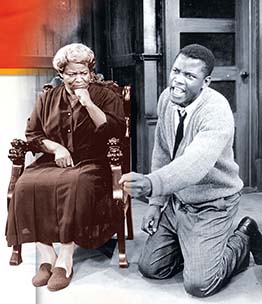American Literature: A Raisin in the Sun by Lorraine Hansberry
The 1940s and 1950s brought an explosion of literature that exposed the harsh discrimination African Americans faced. One of the most powerful writers of the period was the playwright Lorraine Hansberry. Her most famous work, A Raisin in the Sun, focuses on the struggles of a black family living in the South Side of Chicago.
In this excerpt, Lindner—a white man—tries to dissuade the family from moving into his neighborhood.
- LINDNER:
- I am sure you people must be aware of some of the incidents which have happened in various parts of the city when colored people have moved into certain areas—Well—because we have what I think is going to be a unique type of organization in American community life—not only do we deplore that kind of thing—but we are trying to do something about it. We feel—we feel that most of the trouble in this world, … exists because people just don’t sit down and talk to each other.
- RUTH:
- You can say that again, mister.
- LINDNER:
- That we don’t try hard enough in this world to understand the other fellow’s problems. The other guy’s point of view.
- RUTH:
- Now that’s right.
- LINDNER:
- Yes—that’s the way we feel out in Clybourne Park. And that’s why I was elected to come here this afternoon and talk to you people. Friendly like, you know, the way people should talk to each other…. As I say, the whole business is a matter of caring about the other fellow. Anybody can see that you are a nice family of folks, hard working and honest I’m sure. Today everybody knows what it means to be on the outside of something. And of course, there is always somebody who is out to take the advantage of people who don’t always understand.”
- WALTER:
- What do you mean?
- LINDNER:
- Well—you see our community is made up of people who’ve worked hard as the dickens for years to build up that little community. They’re not rich and fancy people; just hard-working, honest people who don’t really have much but those little homes and a dream of the kind of community they want to raise their children in. Now I don’t say we are perfect and there is a lot wrong in some of the things they want. But you’ve got to admit that a man, right or wrong, has the right to want to have the neighborhood he lives in a certain kind of way. And at the moment the overwhelming majority of our people out there feel that people get along better, take more of a common interest in the life of the community, when they share a common background. I want you to believe me when I tell you that race prejudice simply doesn’t enter into it. It is a matter of the people of Clybourne Park believing, rightly or wrongly, as I say, that for the happiness of all concerned that our Negro families are happier when they live in their own communities.
- BENETHEA:
- This, friends, is the Welcoming Committee!

▲ Scene from a production of A Raisin in the Sun
Thinking Critically
- Synthesize Information What reasons did Lindner give for not wanting the family to move into his neighborhood?
- Make Inferences What obstacles did African Americans face in gaining social equality in the 1950s?




